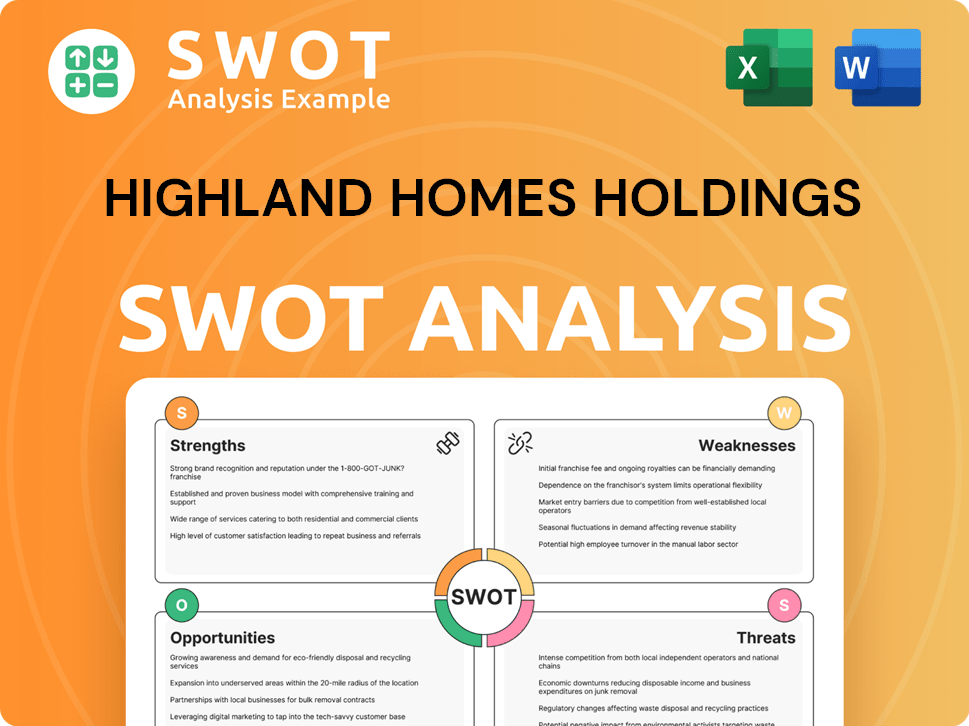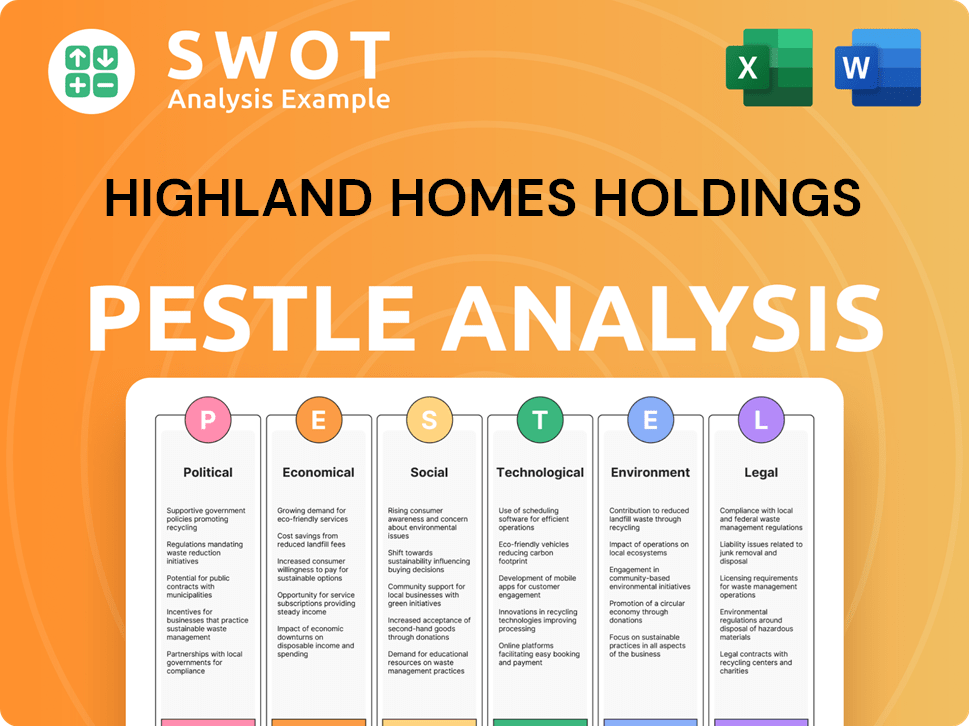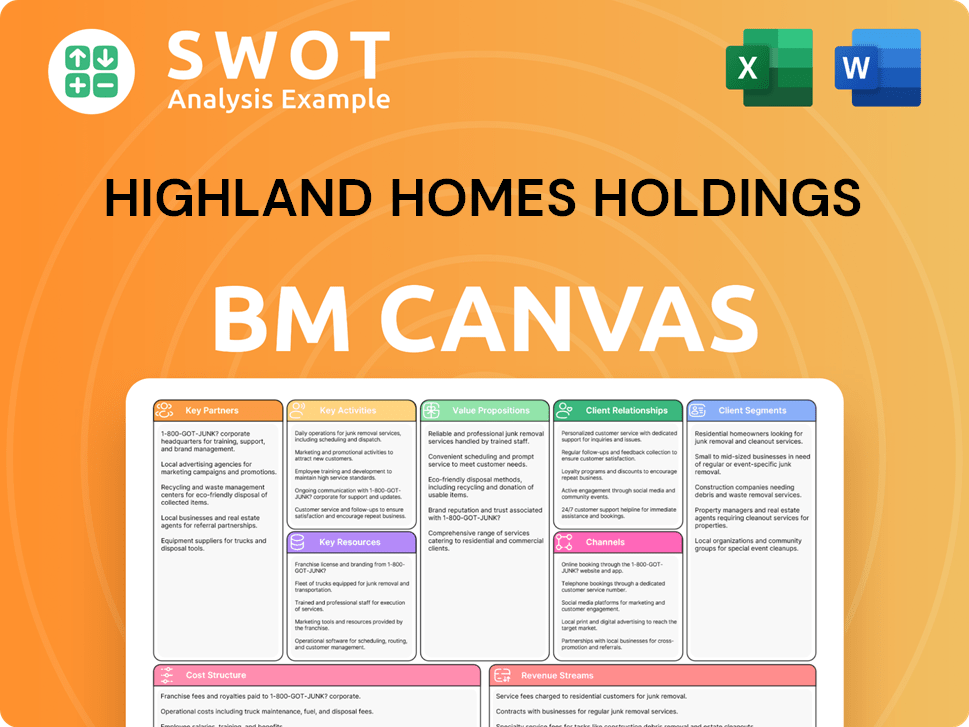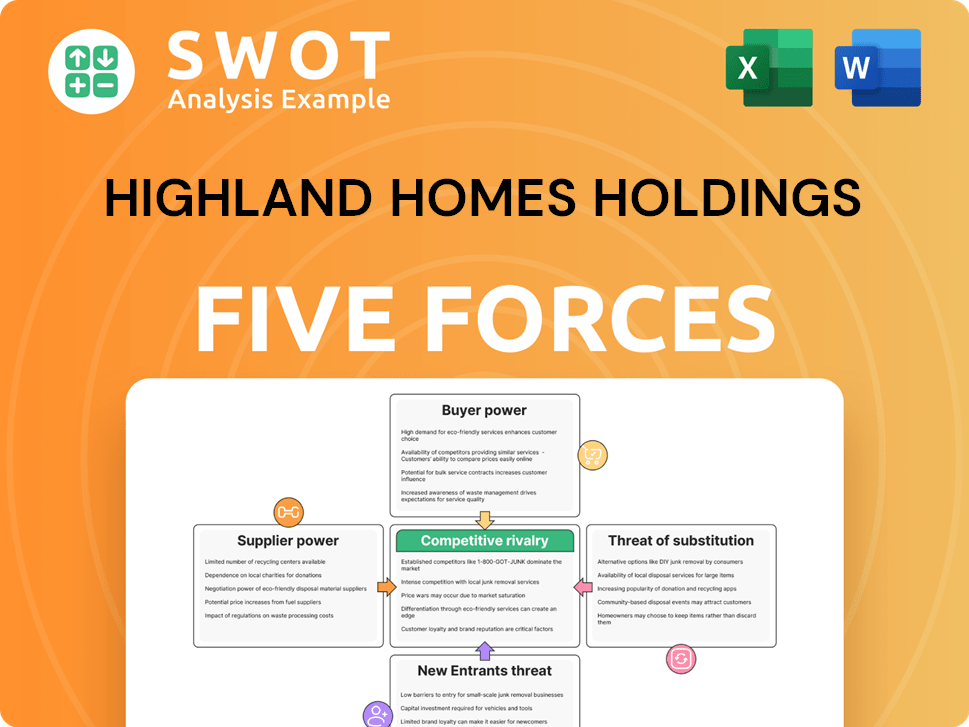Highland Homes Holdings Bundle
How Does Highland Homes Navigate the Cutthroat Homebuilding Industry?
The U.S. real estate market is a battlefield of fluctuating interest rates and shifting consumer demands, making it crucial to understand the players. Highland Homes Holdings Company, a key contender in the homebuilding industry, has strategically positioned itself, particularly in the Sun Belt region. Their focus on single-family homes within master-planned communities sets the stage for a compelling market analysis.

Founded in 1985, Highland Homes has grown significantly, becoming one of the largest privately held homebuilders. This growth, coupled with its adaptive business model, allows it to compete effectively. To understand their position further, we delve into their Highland Homes Holdings SWOT Analysis, examining the competitive landscape, including their market share and identifying key rivals within the homebuilding industry and their impact on the company's financial performance.
Where Does Highland Homes Holdings’ Stand in the Current Market?
Highland Homes Holdings Company maintains a strong market position within the U.S. homebuilding industry, especially in its core operational areas. While specific market share figures for privately held companies are often undisclosed, industry analyses consistently place Highland Homes among the top builders in Texas and Florida. This robust presence is a key component of its competitive landscape.
The company's primary offerings are single-family homes, providing a diverse portfolio of designs and personalization options to cater to various buyer preferences and price points. Its geographic focus is concentrated in high-growth metropolitan areas, specifically Central Florida, Tampa Bay, and the Dallas-Fort Worth area. These regions are characterized by robust population growth and strong demand for new housing, providing a fertile ground for Highland Homes' operations. A detailed Marketing Strategy of Highland Homes Holdings can further illuminate its market approach.
Over time, Highland Homes has consistently focused on the move-up and luxury segments within master-planned communities, maintaining a premium positioning. This strategic focus has allowed the company to cultivate a brand image associated with quality craftsmanship and desirable community living.
In 2024, Highland Homes was recognized as the largest privately held homebuilder in Texas and Florida, reflecting its significant regional dominance. This highlights the company’s strong position within the competitive landscape of the real estate market. The company’s strategic focus on high-growth areas contributes to its continued success.
The company's financial health is generally considered strong, supported by its consistent sales volumes and efficient operational model. In 2023, Highland Homes closed 4,496 homes, generating revenue of $2.4 billion, underscoring its substantial scale compared to many industry averages. This performance highlights its ability to execute effectively in competitive markets.
Highland Homes focuses on master-planned communities, which helps mitigate risks associated with broader market fluctuations. This strategic approach allows the company to maintain a premium brand image and cater to specific buyer segments. The company's concentration in high-growth areas like Dallas-Fort Worth and key Florida markets further strengthens its market position.
- Focus on move-up and luxury segments.
- Emphasis on master-planned communities.
- Geographic concentration in high-growth metropolitan areas.
- Consistent sales volumes and efficient operations.
Highland Homes Holdings SWOT Analysis
- Complete SWOT Breakdown
- Fully Customizable
- Editable in Excel & Word
- Professional Formatting
- Investor-Ready Format

Who Are the Main Competitors Challenging Highland Homes Holdings?
The competitive landscape for Highland Homes Holdings Company is shaped by a complex interplay of national, regional, and local homebuilders. The company operates within the dynamic real estate market, where factors such as land acquisition, construction costs, and consumer preferences heavily influence market share and financial performance. A thorough market analysis reveals the strategic positioning of Highland Homes relative to its key competitors, highlighting both challenges and opportunities for growth.
Understanding the competitive dynamics is crucial for assessing the overall health and future prospects of Highland Homes. This involves evaluating the strengths and weaknesses of its rivals, as well as the broader industry trends that impact the homebuilding industry. Analyzing the competitive landscape provides valuable insights into the company's ability to maintain and enhance its market position, which is essential for investors and stakeholders.
Major national homebuilders represent the most significant direct competition for Highland Homes. These companies, such as D.R. Horton, Lennar Corporation, PulteGroup, and Taylor Morrison, wield considerable influence due to their scale and resources. They often compete aggressively for land and customers.
D.R. Horton, the largest homebuilder in the U.S., competes with Highland Homes on multiple fronts, including geographic footprint and price points. In 2024, D.R. Horton reported revenues of over $36 billion, showcasing its dominant position.
Lennar Corporation challenges Highland Homes through its focus on efficiency and standard features. Lennar's revenue in 2024 was approximately $34 billion. This focus allows them to streamline the homebuying process and attract a wide customer base.
PulteGroup, with its diverse brand portfolio, competes across various buyer segments. PulteGroup's revenue in 2024 was about $16 billion. This diversification allows PulteGroup to target different market niches.
Taylor Morrison focuses on move-up and luxury segments, directly competing with Highland Homes in similar master-planned developments. Taylor Morrison's revenue in 2024 was around $10 billion, reflecting its focus on higher-end markets.
National builders leverage their scale for land acquisition and supplier negotiations. Marketing campaigns and bidding wars for land parcels are common competitive tactics. For example, in the Dallas-Fort Worth market, competition is fierce among all major builders.
Beyond the national giants, Highland Homes faces competition from regional builders. These companies often possess deep local market knowledge and cultivate strong relationships. They may compete on customization, local expertise, and community-specific branding. Emerging players, such as those focusing on sustainable building practices, can also disrupt the landscape, though their impact on Highland Homes' core business remains limited due to their smaller scale. Mergers and acquisitions are reshaping the competitive dynamics, leading to increased industry consolidation. For further insights into the company's ownership and financial structure, consider reading more about Owners & Shareholders of Highland Homes Holdings.
Several factors drive competition in the homebuilding industry, influencing the competitive landscape for Highland Homes. These include:
- Land Acquisition: Access to prime land parcels is crucial, with competition intensifying in desirable locations.
- Construction Costs: Managing costs effectively is essential for profitability, with fluctuations in material prices and labor costs impacting all builders.
- Marketing and Sales: Effective marketing campaigns and sales strategies are vital for attracting homebuyers.
- Customer Preferences: Understanding and adapting to evolving customer preferences regarding home design, features, and sustainability is critical.
Highland Homes Holdings PESTLE Analysis
- Covers All 6 PESTLE Categories
- No Research Needed – Save Hours of Work
- Built by Experts, Trusted by Consultants
- Instant Download, Ready to Use
- 100% Editable, Fully Customizable

What Gives Highland Homes Holdings a Competitive Edge Over Its Rivals?
In the dynamic real estate market and homebuilding industry, understanding the competitive landscape is crucial. Highland Homes Holdings Company has established several key advantages. These advantages help it stand out from its competitors. This article will explore these advantages. It will also analyze how they contribute to the company's success. The company's strategic moves and market positioning are also important.
Highland Homes Holdings Company has built a strong brand reputation. This is a significant advantage. It focuses on quality and customer service. The company's commitment to customer satisfaction is a key factor. It has helped build strong customer loyalty. This loyalty is essential in the homebuilding industry. It also helps the company maintain a competitive edge. This advantage is seen in customer reviews and industry awards.
The company's focus on master-planned communities is another key advantage. These communities offer a lifestyle that attracts homebuyers. They often include amenities and better infrastructure. This approach differentiates Highland Homes Holdings Company from builders. It also allows it to secure prime locations. This strategic focus creates a distinct value proposition in the market analysis.
Highland Homes Holdings Company has built a strong brand reputation. This is a significant advantage. It focuses on quality and customer service. The company's commitment to customer satisfaction is a key factor. It has helped build strong customer loyalty. This loyalty is essential in the homebuilding industry.
The company's focus on master-planned communities is another key advantage. These communities offer a lifestyle that attracts homebuyers. They often include amenities and better infrastructure. This approach differentiates Highland Homes Holdings Company from builders. It also allows it to secure prime locations.
Highland Homes Holdings Company provides personalization options. This allows homebuyers to customize their homes. This caters to individual preferences. It also creates a stronger sense of ownership. This level of customization can command higher price points, enhancing the customer experience.
Operational efficiencies contribute to Highland Homes Holdings Company's cost-effectiveness. These are refined over decades. This allows the company to deliver homes on schedule and within budget. This is a significant advantage in the homebuilding industry. It also enhances customer satisfaction and trust.
Highland Homes Holdings Company has several competitive advantages. These advantages include a strong brand reputation and customer loyalty. It also has a strategic focus on master-planned communities. The company's personalization options and operational efficiencies are also important. These factors contribute to its success in the homebuilding industry.
- Strong brand reputation and customer loyalty.
- Strategic focus on master-planned communities.
- Personalization options for homebuyers.
- Operational efficiencies and cost-effectiveness.
The company's ability to secure prime land in master-planned communities faces challenges. These challenges include competition and rising land costs. However, Highland Homes Holdings Company continues to leverage its advantages. It does so in its marketing and product development strategies. Further insights into the company's financial performance and business model can be found in Revenue Streams & Business Model of Highland Homes Holdings.
Highland Homes Holdings Business Model Canvas
- Complete 9-Block Business Model Canvas
- Effortlessly Communicate Your Business Strategy
- Investor-Ready BMC Format
- 100% Editable and Customizable
- Clear and Structured Layout

What Industry Trends Are Reshaping Highland Homes Holdings’s Competitive Landscape?
The homebuilding industry is experiencing a dynamic shift, influenced by technological advancements, evolving consumer preferences, and regulatory changes. These factors significantly shape the competitive landscape for companies like Highland Homes Holdings Company. Understanding these trends is crucial for assessing its market position, identifying potential risks, and forecasting its future outlook.
The real estate market, particularly in regions where Highland Homes operates, is subject to fluctuations in interest rates, construction costs, and consumer demand. Market analysis reveals that the ability to adapt to these changes is critical for sustained growth and profitability. The company's strategic responses to these industry dynamics will determine its success in the coming years. For a deeper dive, consider reading about the Growth Strategy of Highland Homes Holdings.
Technological advancements are driving the adoption of smart home technologies and sustainable building practices. Consumer preferences are leaning towards flexible living spaces and energy-efficient homes. Regulatory changes, including zoning and building codes, continue to impact construction costs and timelines.
Rising interest rates and inflation in construction materials can squeeze profit margins. Increased regulation may lead to higher compliance costs and longer development cycles. New competitors, including those specializing in modular homes, could disrupt traditional homebuilding models.
Strong housing demand in Texas and Florida, driven by population growth, provides a solid foundation. There's an opportunity to capitalize on the demand for sustainable and smart homes. Strategic partnerships and expansion into new markets could drive growth.
Operational efficiency, product innovation, and maintaining a strong brand reputation are crucial. Adaptation to changing market dynamics is key to remaining competitive. Focusing on customer needs and offering value-added services can enhance market position.
The homebuilding industry's competitive landscape is constantly evolving, requiring strategic agility. Understanding the interplay of industry trends, future challenges, and emerging opportunities is crucial for sustained success. Highland Homes must focus on operational efficiency to maintain profitability.
- Market Analysis: Continuously monitor real estate market trends, including interest rates and consumer demand.
- Product Innovation: Integrate smart home features and sustainable building practices to meet evolving consumer preferences.
- Strategic Partnerships: Collaborate with technology providers and land developers to enhance offerings and secure desirable locations.
- Operational Efficiency: Streamline construction processes and manage costs effectively to maintain profitability.
Highland Homes Holdings Porter's Five Forces Analysis
- Covers All 5 Competitive Forces in Detail
- Structured for Consultants, Students, and Founders
- 100% Editable in Microsoft Word & Excel
- Instant Digital Download – Use Immediately
- Compatible with Mac & PC – Fully Unlocked

Related Blogs
- What are Mission Vision & Core Values of Highland Homes Holdings Company?
- What is Growth Strategy and Future Prospects of Highland Homes Holdings Company?
- How Does Highland Homes Holdings Company Work?
- What is Sales and Marketing Strategy of Highland Homes Holdings Company?
- What is Brief History of Highland Homes Holdings Company?
- Who Owns Highland Homes Holdings Company?
- What is Customer Demographics and Target Market of Highland Homes Holdings Company?
Disclaimer
All information, articles, and product details provided on this website are for general informational and educational purposes only. We do not claim any ownership over, nor do we intend to infringe upon, any trademarks, copyrights, logos, brand names, or other intellectual property mentioned or depicted on this site. Such intellectual property remains the property of its respective owners, and any references here are made solely for identification or informational purposes, without implying any affiliation, endorsement, or partnership.
We make no representations or warranties, express or implied, regarding the accuracy, completeness, or suitability of any content or products presented. Nothing on this website should be construed as legal, tax, investment, financial, medical, or other professional advice. In addition, no part of this site—including articles or product references—constitutes a solicitation, recommendation, endorsement, advertisement, or offer to buy or sell any securities, franchises, or other financial instruments, particularly in jurisdictions where such activity would be unlawful.
All content is of a general nature and may not address the specific circumstances of any individual or entity. It is not a substitute for professional advice or services. Any actions you take based on the information provided here are strictly at your own risk. You accept full responsibility for any decisions or outcomes arising from your use of this website and agree to release us from any liability in connection with your use of, or reliance upon, the content or products found herein.